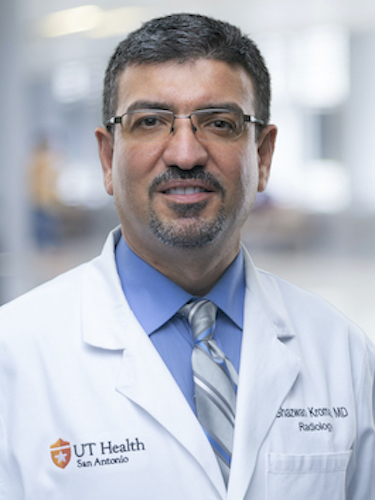Interventional Radiology Residency

The Interventional Radiology – Integrated Residency strives to provide an excellent, well-rounded educational experience in imaging, image guided therapy, radiological science, and radiological research for medical students and residents. The Interventional radiology residency exposes residents to a wide variety of high-volume interventional vascular procedures while allowing them to develop strong foundational skills for excellent patient care.
Congratulations on your decision to pursue a career in the field of Radiology; you have chosen a dynamic, challenging, and rewarding specialty. In no other area of contemporary medicine has the impact of technology been so great. Multislice CT scanners can freeze a beating heart, high field MRI allows diagnosis based on the chemical composition of tissues, and tumor-specific radionucleotides offer new ways to diagnose, monitor and even treat cancer. Nearly all aspects of medical practice depend on some sort of imaging today.
UT Health at San Antonio offers Interventional Radiology training in one of the following pathways:
- Integrated IR Residency: The integrated residency is an advanced five-year program that takes place after an an ACGME accredited Interventional Radiology Fellowship. There will be no detracting from the educational opportunities available to residents in the diagnostic radiology residency as the PGY2-PGY4 years are identical to the PGY2-PGY4 years of diagnostic radiology (DR) residency. As with diagnostic radiology, residents take the American Board of Radiology core exam at the end of the PGY4 year. The PGY5-PGY6 years are devoted to interventional radiology and include procedural rotations; however, It will be possible to do DR rotations to meet regulatory requirements during these years.
- Independent IR Fellowship: The Independent IR Fellowship is a two-year program (PGY6-PGY7) that takes place after completion of DR residency. It includes the components of IR residency (procedural experience and patient care experience that includes ICU, inpatient service, consult service and outpatient clinic) that take place in the PGY6 years of the Independent program. The independent diagnostic residency experience may take place at an institution other than the one where the DR residency was completed.
- Early Specialization in Interventional Radiology (ESIR): is a training option for diagnostic radiology residents who identify an early desire to specialize in interventional radiology. It requires a total of 11 interventional radiology or interventional radiology-related rotations. ESIR candidates must still complete an independent IR residency to finish their IR training and be eligible for the American Board of Radiology (ABR) IR/DR Certifying Exam. Completion of the ESIR requirements allows advance placement into the 2nd year of the independent IR residency, reducing the total training time to only six years.
Our goals and objectives are to provide you an opportunity to train with bright, enthusiastic colleagues in a friendly, supportive environment. To that end, we have assembled a faculty of experienced, talented, and dedicated subspecialists who not only enjoy their work but are committed to teaching and to excellence in patient care. The training programs are designed to obtain maximum benefit from the large volume of clinical material and the broad range of pathology encountered at the well-equipped hospital and outpatient centers affiliated with the program. Our conference curriculum is well organized and is aimed at preparing residents for the Core exam.
Combine our focus on education with the many attractions and amenities of a large southwestern city with a year-round temperate climate, and you have the formula for a successful and enjoyable residency experience. We hope this website conveys a sense of the quality and convivial atmosphere of our department, and we look forward to receiving your application.
UT Health’s Interventional Radiology – Independent Fellowship
The UT Health’s Interventional Radiology – Independent Fellowship section provides minimally invasive procedure services for San Antonio’s University Hospital and UT Medicine Systems; including imaging centers at University Hospital and Robert B. Green Clinic. Our section is composed of 7 board certified radiologists who have achieved additional subspecialized training through ACGME certified Interventional Radiology – Independent Fellowship. The section provides a wide range of minimally invasive procedures that can be performed as ambulatory outpatient visits or require just short observation admission periods, typically less than 24 hours. See a list of some of our minimally invasive percutaneous procedures.
Contact Us
UT Health San Antonio
Dept. of Radiology
MSC 7800

UT Health at San Antonio has a superb Interventional Radiology training Program that dated back to 1994 when Interventional Radiology was first recognized as a medical specialty by the ABMS and the AMA. Great pioneers and Gold medalist in IR came from this institution including but not limited to Dr. Palmaz; the inventor of the first balloon mounted stent graft.
-Ghazwan M Kroma, M.D.
Residency Program Director
